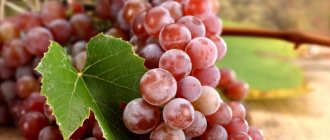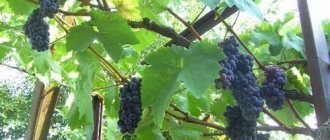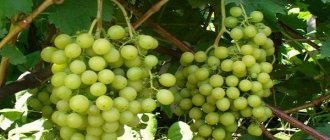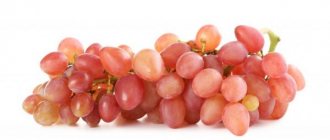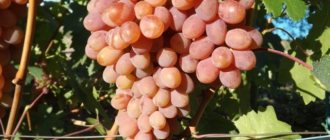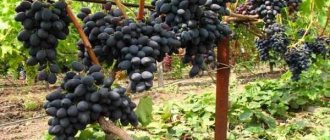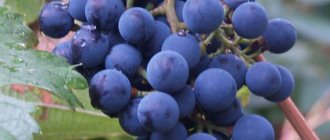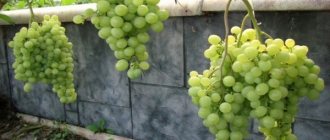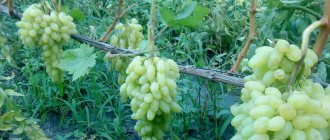When growing grapes, many gardeners give preference to early ripening varieties in order to see the harvest as early as possible. And, besides, in many regions of our country the summer is not so long - early varieties therefore have the opportunity to ripen. Popular varieties with early ripening include Super Extra, which can safely grow and bear fruit even in the shady part of the plot.
This is a domestic variety, and in the article we will tell you more about it: we will find out the productive and external qualities of this grape, we will find out how to plant it correctly, and how to then care for it. In addition, we will get acquainted with the opinions of winegrowers who have already successfully cultivated this variety on their plots.
History of selection
According to the originator, the variety is the result of a combinative selection carried out by E. G. Pavlovsky in collaboration with specialists from the All-Russian Research Institute of Viticulture and Winemaking named after. Ya. I. Potapenko.” Some sources indicate that during breeding, the Talisman and Cardinal grape varieties (+ pollen mixture) were used for crossing.
Grape varieties that served as parent forms: "Talisman" (left) and "Cardinal" (right)
At the end of the 90s of the last century, this hybrid form attracted serious attention of professional breeders and was thoroughly studied both in farmer-amateur plantings and in experimental production farms on the southern coast of Crimea, Anapo-Taman, Foothill and Central zones of Kuban, as well as in Ukraine.
In 2013, “Super-Extra” was submitted for testing in the State Testing System of the Russian Federation, given a new name “Citrine”, and in 2015 it was officially registered in the State Register of Breeding Achievements as intended for private production of table grapes in all regions of Russia. The variety is protected by a copyright certificate and patent.
Currently, this type of crop is successfully cultivated not only in Russia, but also in Ukraine, Belarus and other post-Soviet countries. You can get acquainted with its features in more detail from the video filmed by a Belarusian amateur winegrower:
Description of the plant and specifics of cultivation
The vine has great vigor, with well-ripening shoots. The perennial parts of the bush are covered with reddish, coarse-fibrous bark. The leaves are simple, medium-sized, five-lobed, slightly or moderately dissected, dark or light green, smooth, without pubescence. The flowers are greenish, small (3-5 mm in diameter), bisexual. Like most grape plants, “Super-Extra” does not need joint planting with specially selected pollinator varieties.
Bushes are fast-growing, densely leafy
Fruitful shoots range from 75 to 95%, on average the load on each is 1.4-1.5 bunches. Shoots that are too thin and grow from the head of the bush are not allowed to bear fruit. The length of pruning fruit shoots significantly affects the plant's yield and fruit quality. Experienced winegrowers advise cutting the fruit shoots to an average of 6-8 buds when using a multi-arm fan formation.
If the bushes are led along a multi-armed fan (from 4 to
system, without boles), then two important advantages will become obvious: it is convenient to cover the vine for the winter, since due to the elasticity the medium and long arms easily bend to the ground, and it is also possible to leave a large load on the bush eyes. For “Super-extra” they recommend approximately 40-50 healthy eyes per bush.
Methods of propagation of grapes
There are 3 most common methods of grape propagation:
- By cuttings.
- Seeds.
- By layering.
Reproduction of a crop by cuttings, grafting and layering is a vegetative type of propagation, and by seeds is a sexual type. Grapes are propagated by seeds exclusively when developing new varieties, since grapes grown from seeds do not retain the properties of the original plant.
The basis for propagating grapes by cuttings is the ability to regenerate lost parts. It was noticed that a section of a stem with a bud can give rise to a new plant. To do this, cut annual shoots with 4 eyes that have already turned into vines. After processing, the grapes are stored in a cool place. The final stage is growing the seedling in a glass.
When propagating grapes by layering of seedlings, you will get few seedlings, but the harvest can be harvested faster. In late autumn, you need to take annual shoots and place them in a hole 30 cm deep. Then fill the shoot with fertile soil and add mineral fertilizers. In the spring, the buried vines will begin to produce new shoots. After a year, separate the seedlings along with the soil and transplant them to another place.
Productivity and ripening time
The plant produces its first signal harvest in the 2nd year after planting, marketable fruiting begins in the 4th - on average about 25-30 kg per bush.
The opinion of an experienced Ukrainian gardener about the yield potential can be found in the following video:
According to the results of field tests in the natural conditions of Kuban (when bushes were placed according to a pattern of 3.0 x 1.5-2.0 m, formed like a horizontal cordon or a standardless fan, and growth was carried out on a vertical trellis), five-year-old plantings showed a yield of 8.9-11 .0 kg per plant or 14.6-18.1 t/ha. Moreover, during the growing season, care consisted of standard agrotechnical measures.
Removable maturity occurs 90-105 days after bud break. The clusters can remain on the bushes for a long time, without losing the taste of the berries.
The harvest of the Citrine grape variety in the Central zone of Kuban amounted to 18 t/ha
The berries are firmly held on the stalks, without falling off even when harvesting is late. The taste and aroma develop in mid or late July. Properly picked fruits are stored well in the refrigerator for more than 2 months. The juicy pulp is reliably protected from damage by a thick skin, which is practically not injured during transportation.
How to care
In general, the variety is adapted to the Russian changeable climate and is quite unpretentious. Super Extra grapes can grow on any soil, even acidic and dense. However, the best harvest quality can be achieved by planting the shrub in light, fertile soil. Let's find out the main points for caring for this plant.
Watering and mulching
This grape variety is moisture-loving: it is recommended to water the bush once every two weeks. Under each adult bush you need to pour from 12 to 5 liters of water. And in the first 4 weeks after rooting of a young plant, it must be watered once a week. This measure will help the grapes quickly adapt to new conditions.
2-3 liters of water are poured under the young cuttings per watering. After watering, the root circle of the plant must be mulched with a 3-centimeter layer of moss or rotted sawdust.
Water for irrigation should be warm and settled. The soil should not be over-moistened, as this can lead to subsequent cracking of the fruit.
The video shows how to properly care for a vineyard:
Loosen the soil after watering to ensure good air exchange in the ground. However, you should not loosen deeply: do not forget that the root system of grapes is superficial. At the same time, when loosening, remove all weeds that get in the way.
But how to grow grapes from chibouk, as well as how to do all the work yourself with your own hands, is described in great detail in the article at the link.
It will also be useful to learn how to plant grapevines in winter.
What are the technical varieties of grapes for the middle zone, as well as what they are called and look like, you can find out from the article at the link: //gidfermer.com/sadovodstvo/frukty/vinograd-sorta-dlya-srednej-polosy-rossii.html
It will also be useful to learn about how Nitroammofosk fertilizer is used for grapes, and how to do it correctly.
Top dressing
Super Extra grapes require increased nutrition because they produce very large berries and clusters. It is best to feed the plant in the spring, after hibernation. It is advisable to use organic matter as fertilizers, alternating it with potassium-phosphate and nitrogen compounds. The shrub responds very well to adequate fertilizing, thanks to its rapid growth and excellent harvest.
It is recommended to fertilize twice during the season: just before the bush begins to flower, and immediately after the end of this period.
Trimming
To prevent overloading of bunches on the bush, Super Extra grapes must be pruned in a timely manner. Experienced agronomists recommend leaving no more than 25 buds on one bush: this protective measure will help to grow a few bunches, but they will be really large, and the berries will be sweet and of high quality.
It is better to carry out the pruning procedure in the fall, so that by spring the shrub is completely ready for the growing season.
Regularly inspect the vine for damaged and dried branches, and promptly remove them if found. This procedure is mandatory in the spring after the plant has overwintered. This measure will help the grapes start the growing season strong, strong and healthy, freed from the unnecessary burden of diseased and weak branches.
The video shows the correct pruning of a grapevine:
Wintering
The plant is frost-resistant, but only if the outside temperature does not drop below -24 degrees. If you live in a climate with harsher weather, you will need to cover your grapes for the winter. In very harsh climates, it is recommended to grow Super Extra in a greenhouse.
For the winter, you can cover the vine with spruce branches, agrofibre, straw, and other suitable materials available. When you remove the protective cover in the spring, be sure to tie the vine to a support (trellis).
Prevention
Before the flowering period begins, it is highly advisable to spray the bush with Bordeaux mixture to protect it from infections, fungus and rot.
You may also be interested in information about how grapes are grown in a greenhouse.
Fruit characteristics
The clusters are very large, conical, with a wing, of medium density, weighing about 500-700 g, maximum - more than 1 kg. The berries are not leveled: large, sometimes smaller, weighing on average 6-8 g (up to 13 g), do not crack. In the main harvest, the fruits are oblong in shape. The color of the skin is light green, matte yellow when fully ripe. The skin is dense and easy to eat.
During the flowering period, under unfavorable weather conditions (too hot or, conversely, rainy and cool summer), the variety tends to produce peas.
The pulp is juicy, fleshy, dense, crispy, with a simple sweet taste. Each berry has only two seeds, which are easily separated from the pulp. Professional tasting assessments of taste - 8.9 points (out of 10) , most summer residents find the taste “sweet” with light floral notes and call it “standard” grape.
Fruits for dessert (universal) purposes - excellent for fresh consumption; they are used for making jam, confitures, compotes, juices, raisins and other processing methods
Biochemical studies carried out by specialists from the Kuban State Agrarian University to determine the nutritional value of the fruits revealed that in the conditions of the viticultural zones of the Krasnodar Territory, the “Super-extra” sugar content was 17.3% with an acidity of 6.4 g/l. The ratio of sugar and acid is harmonious, the taste is pleasant and sweet.
Advantages and disadvantages of the variety
Amateur winegrowers call the disadvantages of the variety
The main advantages are considered to be high yield and very early ripening.
The positive aspects of “Super-Extra” include: super-early ripening, fruits with a pleasant taste, high yield, and transportability. In addition, according to the results obtained during field tests in the natural conditions of the Kuban, this variety of crop is weakly affected by mildew, gray mold and oidium.
Disease Prevention
As already noted, while resistant to oidium and mildew, Super Extra grapes are defenseless against phylloxera. Therefore, for preventive purposes, bushes must be sprayed with Bordeaux mixture before flowering.
To prevent the invasion of dangerous phylloxera, it is best to use insecticides “Aktellik” or “Fozalon” that are not washed off by rain and are safe for bees.
This variety is also not afraid of tick invasion, but with excessive watering or in rainy summers, the berries bursting from excess moisture can be attacked by flies and wasps. Therefore, to prevent such attacks, it is necessary to cover the ripening bunches with a net.
The Super Extra grape variety lives up to its name with its super-early ripening and extra-ability to produce high yields in various climatic conditions, for which it is highly valued by winegrowers both in summer cottages and on agricultural plantations.
Reviews from gardeners
Konstantin, 67 years old, Krasnodar region
On our five-year-old Super-Extra, the clusters ripen after the 20th of July. Each brush is elegant, without “peas”, weighing more than a kilogram. The berries are smooth and juicy, the flesh is dense, crispy, with a slight nutmeg. They are similar in appearance to Arcadia, but the taste is much sweeter and more aromatic. True, after heavy rains the berries “cracked” a little, but there were no fungal diseases. I regularly trim the lower leaves to ventilate and illuminate the bushes. In general, the variety is reliable, unpretentious in care and excellent for our area.
Alexander, 43 years old, Pinsk
In our vineyard, among the white table varieties, Citrine is the very first to ripen. I would call the growth strength of the bushes average, but the vine is loaded well. Berries of different sizes appear from time to time, although overall pollination is good. Unlike Tenderness and Summer Muscat, the fruits do not crack and are not attacked by wasps. The bushes are responsive to the addition of organic matter, and the clusters gain quite decent sizes. The largest one weighed almost 1.5 kg. Next spring I will plant a couple more seedlings of this variety, and I will prepare the holes in the fall. We always recommend this grape to friends and acquaintances.
Nuri, 43 years old, Evpatoria
We have 8 bushes growing - two are grafted, the rest are our own. I consider one of the main advantages of “Super-Extra” to be its extremely early ripening period. At the end of July, about 25 kg were collected from each bush from six-year-olds. The vine has ripened not only to the third wire of the trellis, but almost to the very tips. For the sake of experiment, I did not mint some of the shoots.
Elizaveta, 45 years old, St. Petersburg
This is the second year I have been growing Citrine in a greenhouse. This season there were signal clusters of 1200. They ripened in mid-August. The clusters are elegant, moderately loose, large, with golden sugar berries. The vine did not ripen very well, but it was enough for my needs. In the fall I will additionally cover it with spunbond. An excellent variety for northern latitudes. Thanks to the people's breeders, with their light hand the grapes are moving to our region.
